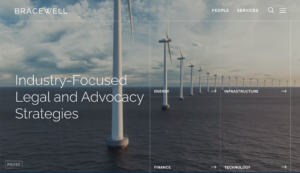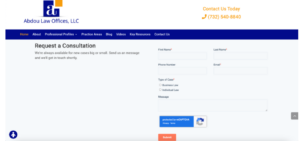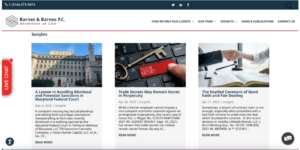
Website Design Tips to Reduce Bounce Rate
High bounce rates are bad for business. For web marketers, reducing bounce rate is an important part of strategy. Bounce rates can provide key insights that reveal opportunities. If you can identify high bounce rates, you can then take steps to increase site engagement and improve site performance by using these law firm website design principles.
High Bounce Rates and Law Firm Website Design
Before we dig into tactics for reducing bounce rates, let’s make sure we understand what bounce rates are and how they can be negative or positive. According to Google:
Bounce rate is single-page sessions divided by all sessions or the percentage of all sessions on your site in which users viewed only a single page.
Essentially, this means that when a visitor “bounces” from a webpage, they have left not just that page but the entire website after viewing only one page. Many people think of bounce rates as strictly negative because they can indicate a poor user experience. For example, a site visitor made it to a page but then the content didn’t deliver what they expected. However, a high bounce rate can also reflect some good things, like a visitor finding exactly what they were searching for immediately and simply leaving the page.
Tactics for Reducing a Negative Bounce Rate With Law Firm Website Design
If you’ve determined that a high bounce rate is not due to positive elements, then you want to put effort into reducing it. Here are 20 ways to decrease bounce rates with law firm website design principles.
1. Review Load Times
A user waiting more than a few seconds for a page to load is a bad user experience and they’re likely to leave. Regularly pull reports of your web pages’ load times. Having a fast loading site is absolutely critical if you want to reduce your bounce rate. You can reduce load times by…
- Compressing and optimizing images
- Reducing redirects
- Caching web pages
- Enable browser caching
- Leverage a content delivery network
- Eliminate unnecessary plugins
2. Don’t Neglect Site Search
Adding site search functionality provides a much better experience for users by helping them quickly locate the information they want.
3. Keep Navigation Easy
Navigation should be as simple as possible for users. Provide clear direction on where content lives and how to get there. Make sure the nav appears in the same place on every web page. This will ensure it’s easy for users to find. Break up subtopics into larger topics to keep things organized, as well. And always have your logo lead back to your home page when clicked.
4. Make Sure Design is Intuitive
Great design builds trust with a user and is a signal of quality to search engines. Design isn’t just about aesthetics but also functionality, ease of use, and overall experience. Everything humans know how to do they’ve learned at some point. Make sure the same design principles and elements are being used on each and every web page so the design is easy to understand.
5. Keep Mobile Top-of-mind
Research shows that mobile users have even less patience than desktop users. Focus on responsive design so that you don’t lose mobile traffic. To improve mobile usability, follow these guidelines:
- Use PageSpeed insights to ensure your site loads fast on mobile
- Optimize for voice search
- Ensure all images and videos are available and sized correctly for small screens
- Minimize pop ups
6. Keep Web Content Clear
It’s important that the copy on your pages is easy to read and effectively formatted. Visitors don’t want to see large chunks of unorganized text. Make sure content is formatted simply, with smaller blocks of text, bulleted lists, etc.
7. Write Short Paragraphs
Similar to the point above, keeping content concise improves readability. Create copy that your visitors can quickly read and consume. Leverage bullet points, headings, and subheadings so users can easily skim content.
8. Use a Variety of Content
Using multiple forms of content can better engage site visitors. Use a mix of high-quality images, video content, and infographics.
9. Focus on Relevant Keywords
Using relevant keywords that are really appropriate for the topic of the content ensures that users are finding what they’re looking for. Review content for accuracy in words, sentences, and paragraphs. Remember that the more visitors land on the content they were looking for, the less likely they are to leave the page.
10. Target a Specific Audience
Similar to using relevant keywords, focusing on the people who will read your content will ensure your audience gets to the content they want to view. Identify your core target audience and tailor content to them. If your targeting is too broad, you’re more likely to see a higher bounce rate.
11. Use Pop-ups Tactfully
As a general law firm website design principle, users don’t enjoy being interrupted. Try to limit items that will keep users from getting directly to relevant content. Let them scroll and consume information before diverting their attention. When using pop-ups, make sure they’re tactful and are offering relevant content that will get the user to stay longer. And try to avoid invasive full screen pop-ups. Also, set up your pop ups so they appear with exit intent.
12. Limit Advertising
If you use ads on your page, be careful about their use and placement. Though some ads can perform well, they can also be a distraction. Large or oddly placed ads take away from the user experience.
13. Make the CTA Clear
Next steps should be obvious on every webpage. Users should be able to locate the CTA within a few seconds of being on a page. Use bright contrasting colors to make sure CTA stand out and consider using an interactive button as well.
14. Take Care of Broken Links
Large numbers of broken links are really bad for user experience. Make it a point to find any of the broken links on your website. Use Google Search Console or a site auditing tool like Screaming Frog to pull a list of links that need attention.
15. Spend Time on an Internal Link Strategy
Internal links can encourage users to stay on your website. This is a good way to let users easily navigate to the content they’re looking for.
16. Make Sure That Links Open on a New Tab
As part of a well-defined internal link strategy, you should make sure that links open in new tabs. Not only does this ensure users spend longer on your website, but it prevents them from clicking away from your site into a new one.
17. Use a 404 Page That is Helpful
A 404 page needs to communicate not only that the chosen page is not found, but alternative pages for a user to navigate to. Simply saying “page not found” won’t keep users on your website.
18. Consistently Publish New Content
Having new and interesting content entices people to stay on your site longer. Even if they only came to look at one specific item, they might be inclined to look around.
19. Include Trust Signals Like Reviews
Even if they don’t realize it, users are constantly evaluating your website to see how trustworthy and credible your firm is. Highlighting things like positive reviews or testimonials shows visitors how reliable your firm is. You can also include special seals and other features that keep your site secure.
20. Leverage Google Analytics and Other Tools
There are so many platforms that can help you track user engagement as well as other important metrics. Google Analytics will show you Time on site, Bounce rate, Pages per session, and much more.
21. Follow a Visual Hierarchy
How text and elements are placed has a big influence on how users navigate your site, and whether or not they find the site easy to use. If they don’t find it easy to navigate, then they will click off too soon. Remember the rules of visual hierarchy:
- Size: the larger an item is the more it will stand out
- Color: the brighter a color is the more attention it will draw
- Contrast: dramatically contrasting colors will attract attention more
- Alignment: alignment creates order between design elements
- Repetition: repeating styles helps users understand how to navigate better
- Whitespace: leveraging whitespace tactfully helps draw the eye to different elements.
Takeaway:
Diagnosing the reason for your high bounce rate will direct you to appropriate action. Spending time discovering your bounce rate and then using these law firm website design tips will increase site visitor engagement and user satisfaction. For more tips on creating a website that operates as a marketing tool and lead generator, start a conversation with our law firm website designers. We’re happy to meet for a free consultation and go over your options.
This post has been edited and republished from Jun. 14, 2022
Are you ready to get started generating new, qualified leads?
Contact us to get started and let us help you energize your digital marketing and business development efforts.
Contact Us





